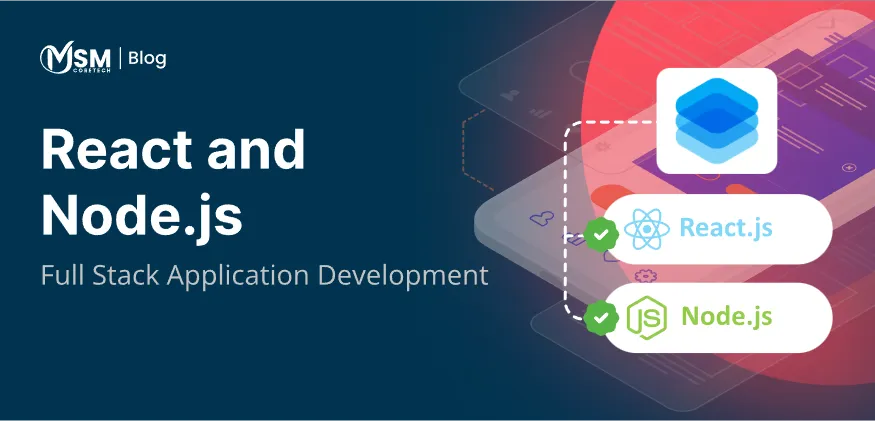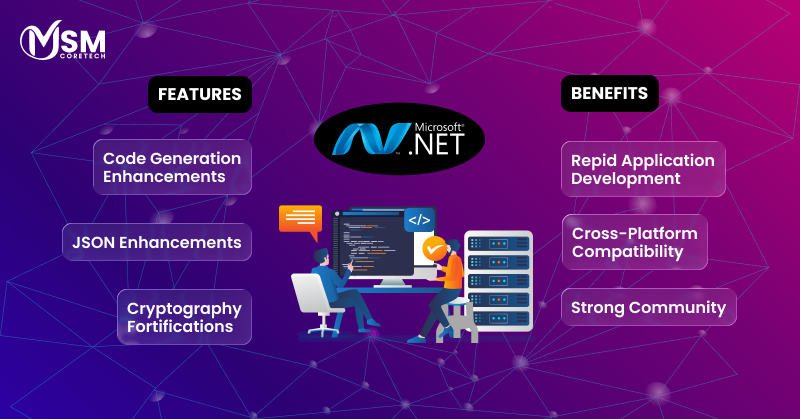Full Stack - React with Node.js Development Services

In the contemporary web development sector, merging technologies to create frontends and backends that operate smoothly is very important. For frontend development (user interface), React.js is considered a reliable library, but for server based runtime environments (backend), there is no stronger library than Node.js. These two are combined together to produce a fully flexible and interactive web application. In this blog, we will discover how to blend React.js with Node.js together, which results in a simple demonstration project often used in Full Stack development services.
Why Use React.js and Node.js Together?
Common Language: React.js and Node.js - they both are JavaScript based libraries, enabling software developers to work around the whole stack using a single language.
Element-Based Architecture: React’s element-based frameworks make it easy to generate redundant UI components, whereas Node.js manages server based tasks effectively.
Efficiency and Reliability: Node.js’s event-oriented framework optimizes the efficiency and reliability of web apps.
Complete Stack: Both React.js and Node.js have massive libraries and plugins that smoothen the whole development procedure. It is the main reason why it is a perfect choice for a full-stack development agency.
Advantages and Disadvantages of React.js with Node.js
Node.js -
Advantages:
Common Language: It relies on JavaScript for both frontend and backend operations to make the development simple.
Speed: Its agile framework based on events makes it suitable for I/O intensive activities.
Reliability: Very much useful for developing network apps and custom structures.
Comprehensive Environment: A huge and more engaging ecosystem or audience with a broad range of modules and libraries made simple by using npm.
Live Application: Its WebSocket service makes it the best fit for live applications like chats or live streaming.
Quick Development: Fast development and prototyping because of the huge number of openly available modules.
Disadvantages:
Single-Threaded Constraints: It is single threaded and is not suitable for processing intensive activities that result in performance glitches during difficult computations.
Callback Hell: Excessive use of callbacks can result in complex and difficult-to-manage code, but Promises and async/await can help mitigate this issue.
Agility: It sometimes does not match the maturity and that agility, like classic backend language or some business-specific applications, as it is new tech.
Debugging and Tooling: The asynchronous nature of Node.js can make debugging and tooling more complicated as contrasted to synchronous programming frameworks.
React.js-
Advantages
Element-Based Architecture: Applications are relatively simpler to handle and scale because of their reusable elements and modular codes.
Virtual DOM: Improves app performance by reducing traditional or Direct DOM modification and upgrading UI carefully.
Developer Tools: A big collection of developer tools and plugins that smoothen debugging and the development procedure.
Effective Community Support: Big community with numerous resources, libraries and third party elements available.
JSX: JavaScript XML syntax enables developers to generate HTML alike code in JS, thereby making the code more accessible and simpler to write.
Adaptability: Highly versatile and can be connected with other libraries or architecture according to certain project needs and requirements.
Disadvantages
Learning Curve: The learning curve of this library is high, particularly for a beginner or for someone not aware of JavaScript ES6 features, JSX and new development tools.
Repetitive Code: It has a noticeable amount of boilerplate or repetitive code and configurations to execute and handle a project.
Frequent Updates: Constantly changing and its updates make it a little difficult to stay updated with the most recent and modern best practices and features.
SEO: SEO is made tough because of few changes from the client side yet this can be minimized with server side rendering (SSR) methods.
State Management Limitations: Handling state can be a bit difficult in large applications and can face regular calls for extra libraries like Context API or Redux.
Process to Configure the Environment for Full Stack Development
First Step: Download Node.js and npm
The first and foremost step is to download and install Node.js from nodejs.org. This will also install Node Package Manager (npm).
Second Step: Create a React Application
Make a React application in order to bootstrap it. Follow:
px create-react-app my-app
cd my-app
npm start
Third Step: Set Up a Node.js Server
Generate a fresh directory for your Node.js server. Write:
mkdir my-app-server
cd my-app-server
npm init -y
npm install express cors
Process to Establish a Node.js Server
The `index.js` file should be created in the `my-app-server` directory:
const express = require(‘express’); const cors = require(‘cors’); const app = express(); const port = 5000; app.use(cors()); const data = [ { id: 1, name: ‘Item 1’ }, { id: 2, name: ‘Item 2’ }, ]; app.get(‘/api/items’, (req, res) => { res.json(data); }); app.listen(port, () => { console.log(`Server is running on http://localhost:${port}`); });
Connect React With Node.js
First Step: Retrieve Data from the API
In your React project, open `src/App.js` and make the following changes:
import React, { useEffect, useState } from 'react';
import './App.css';
function App() {
const [items, setItems] = useState([]);
useEffect(() => {
fetch('http://localhost:5000/api/items')
.then((response) => response.json())
.then((data) => setItems(data));
}, []);
return (
Items
- {items.map((item) => (
- {item.name}
- ))}
);
}
export default App;
Second Step: Set up Proxy for Development
You can configure a proxy in your React project to prevent any CORS related problems during the development process. In the React project's `package.json`, add the following line:
“proxy”: “http://localhost:5000”
Process to Execute the Application
At this point, ensure your React app and Node.js server are both running.
Command to start Node.js server:
cd my-app-server
node index.js
Command to start development server:
cd my-app
npm start
In your browser go to ‘http://localhost:3000’. A list of items retrieved from the Node.js server ought to appear.
This workflow is something a full-stack development firm would also follow when building scalable web applications
Managing Forms and Authentication in Advanced Integration
Managing Forms with React and Node.js
One of the typical use cases in web apps is managing forms. Let's look at how to manage React to Node.js form submissions.
Making a Form in React
Upgrade your React element to incorporate a form:
import React, { useEffect, useState } from 'react';
import './App.css';
function App() {
const [items, setItems] = useState([]);
const [newItem, setNewItem] = useState('');
useEffect(() => {
fetch('http://localhost:5000/api/items')
.then((response) => response.json())
.then((data) => setItems(data));
}, []);
const handleSubmit = (e) => {
e.preventDefault();
fetch('http://localhost:5000/api/items', {
method: 'POST',
headers: {
'Content-Type': 'application/json',
},
body: JSON.stringify({ name: newItem }),
})
.then((response) => response.json())
.then((data) => setItems([...items, data]));
setNewItem('');
};
return (
Items
- {items.map((item) => (
- {item.name}
- ))}
);
}
export default App;
Upgrading the Node.js Server to Manage POST Calls
To handle the POST calls, upgrade your Node.js
const express = require(‘express’);
const cors = require(‘cors’);
const bodyParser = require(‘body-parser’);
const app = express();
const port = 5000;
app.use(cors());
app.use(bodyParser.json());
let data = [
{ id: 1, name: ‘Item 1’ },
{ id: 2, name: ‘Item 2’ },
];
app.get(‘/api/items’, (req, res) => {
res.json(data);
});
app.post(‘/api/items’, (req, res) => {
const newItem = {
id: data.length + 1,
name: req.body.name,
};
data.push(newItem);
res.json(newItem);
});
app.listen(port, () => {
console.log(`Server is running on http://localhost:${port}`);
});
Conclusion
Combining React.js and Node.js together is an ideal combination. It offers a productive frontend with a powerful backend based on the same language. This combination makes it easy to develop, scale and handle an application without having to switch the context. As they both have their own learning curves and limitations, the advantage of this collaboration surpasses the difficulties if used in the right manner. If you are willing to create a clean demo project or an app that is ready for production, React and Node.js offer a powerful, efficient and modern tech stack that can manage anything.
To get the most out of the technology stack, it is important to consider or hire dedicated full-stack developer having proven experience or opt for full-stack development services if you are planning a project at scale.
Related Blogs

The Enduring Popularity of .NET: From Framework to Core and Beyond
Explore why .NET remains a leading development platform, from the classic Framework to modern .NET Core, offering performance, stability, and cross-platform power.
Read More

WebAssembly & Edge Computing: Build Near-Native Speed Apps
WebAssembly combined with edge computing enables developers to build apps that run at near-native speed with minimal latency. This powerful approach delivers faster execution, better scalability, and improved user experience by running code closer to users worldwide.
Read More

How Much Does It Cost To Build Aged Care Management Software?
Discover the complete cost to develop aged care management software. Learn about essential features, pricing factors, tech stack, and tips to reduce overall development costs.
Read More




